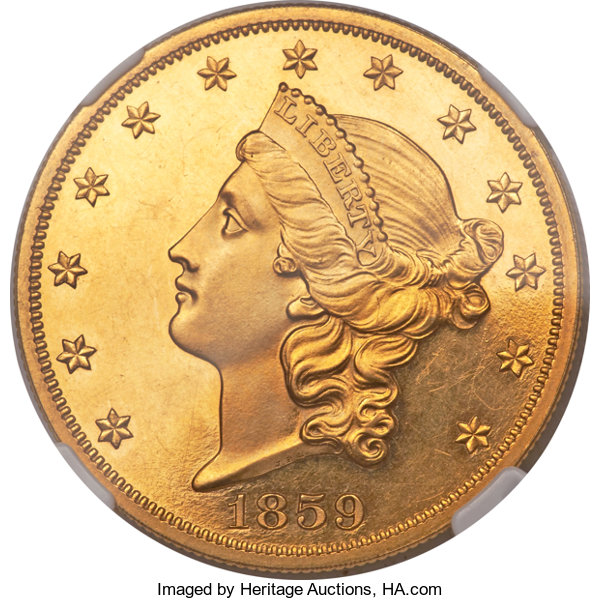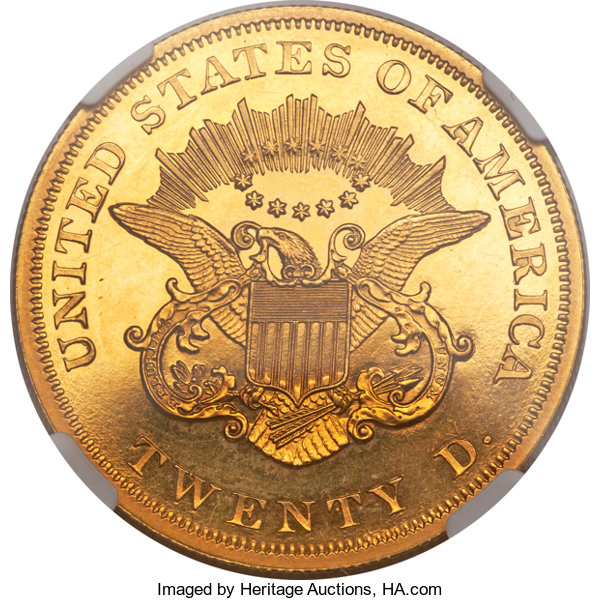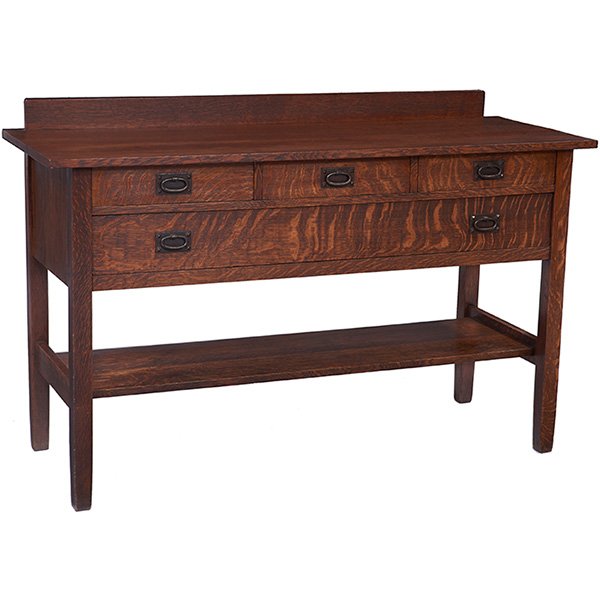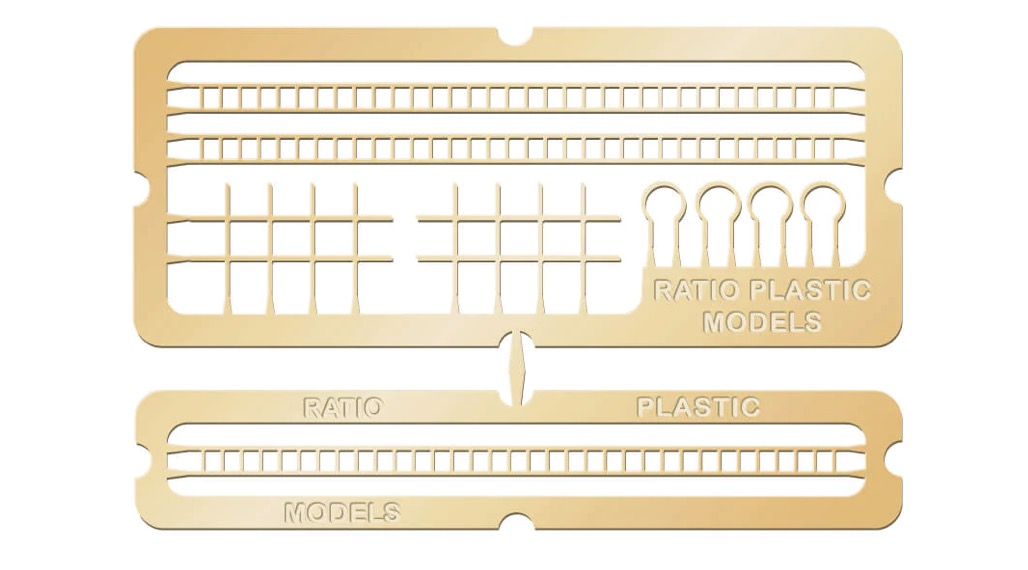Notes: According to Mint records, 80 proof Liberty double eagles were struck in 1859, all for inclusion in the gold proof sets of that year. It was just the second year of the Mint's commercial proof set program, and the enthusiastic response to the first year's offering may have caused some undue optimism about the program's possibilities. Certainly, there were not 80 collectors in the country who were interested in collecting the higher-denomination gold issues at that early date. If that many sets were actually struck, the great majority must have gone unsold, to be melted after the end of the year.
Of the sets that were sold, many were soon broken up, as collecting the larger gold issues was too expensive to be practical for most 19th century collectors. The proof tens and twenties commanded small premiums on the rare occasions when they were offered at auction, and some of these coins were probably melted, or just spent for face value by their owners, during hard times in the Civil War. At least one proof double eagle is known in impaired condition today. Writing in 1907, Samuel Hudson Chapman noted:
"These proof sets are exceedingly rare, and my estimate would be that there are not over five sets in existence of the years prior to 1890, and of some of the earlier years probably only three sets ... it should be borne in mind that during the Civil War and until the resumption of specie payments a large proportion of our gold was sent abroad and remelted."
Jeff Garrett and Ron Guth estimate a surviving population of just 7-8 proof 1859 double eagles in all grades today, including three coins in institutional collections. NGC and PCGS have combined to certify a total of seven coins, including an unknown number of resubmissions and crossovers.
The present coin is a spectacular Select proof that has been off-the-market for 53 years. In its last appearance, in Stack's Wolfson sale in 1962, the cataloger noted, "The appearance is utterly breathtaking." The design elements are sharply detailed throughout, with broad rims, squared-off edges, and a wire rim. The deeply mirrored fields contrast boldly with the frosty devices and the rich yellow-gold surfaces show just a few minor hairlines in the fields. Although two other coins have been offered in the past year, auction appearances are normally infrequent, and it may be years before a comparable example becomes available. Census: 2 in 63 Cameo, 1 finer.
Of the sets that were sold, many were soon broken up, as collecting the larger gold issues was too expensive to be practical for most 19th century collectors. The proof tens and twenties commanded small premiums on the rare occasions when they were offered at auction, and some of these coins were probably melted, or just spent for face value by their owners, during hard times in the Civil War. At least one proof double eagle is known in impaired condition today. Writing in 1907, Samuel Hudson Chapman noted:
"These proof sets are exceedingly rare, and my estimate would be that there are not over five sets in existence of the years prior to 1890, and of some of the earlier years probably only three sets ... it should be borne in mind that during the Civil War and until the resumption of specie payments a large proportion of our gold was sent abroad and remelted."
Jeff Garrett and Ron Guth estimate a surviving population of just 7-8 proof 1859 double eagles in all grades today, including three coins in institutional collections. NGC and PCGS have combined to certify a total of seven coins, including an unknown number of resubmissions and crossovers.
The present coin is a spectacular Select proof that has been off-the-market for 53 years. In its last appearance, in Stack's Wolfson sale in 1962, the cataloger noted, "The appearance is utterly breathtaking." The design elements are sharply detailed throughout, with broad rims, squared-off edges, and a wire rim. The deeply mirrored fields contrast boldly with the frosty devices and the rich yellow-gold surfaces show just a few minor hairlines in the fields. Although two other coins have been offered in the past year, auction appearances are normally infrequent, and it may be years before a comparable example becomes available. Census: 2 in 63 Cameo, 1 finer.
Designer: Christian Gobrecht
History: Following a 34 year hiatus in production for the largest gold denomination, the Liberty Head Gold Eagle was introduced in 1838. The new ten dollar coins would feature a new design by Christian Gobrecht and a reduced weight and diameter. During the next two years, the design would be slightly modified and introduced on the two smaller gold denominations. Besides the addition of the motto on the reverse of the coin, the overall appearance would remain the same until the end of the series in 1907. For a span of nearly 70 years, the Philadelphia Mint and its branch Mints produced the Liberty Gold Eagles, creating many scarce issues and a number of true rarities.
After the production of $10 gold pieces was suspended in 1804, the $5 half eagle served as the largest gold denomination and became the coin of choice for large, mostly overseas transactions. This would remain the case until the early 1830’s when the price of gold had risen such that the melt value of the half eagles and quarter eagles exceeded their respective face values. Under the Coinage Act of 1834, the gold content for each denomination was reduced, which solved the issue for the half and quarter eagle, as well as cleared the way for the reintroduction of the $10 eagle denomination.
The design for the Liberty Gold Eagle was created by Christian Gobrecht, the son of a German born immigrant and a talented engraver. He is also credited with the Liberty Seated design introduced on the silver denominations during the same era. For the gold coins, the head of Liberty appears, facing left. She wears a coronet inscribed LIBERTY with her hair bound in a knot with a beaded ribbon. The date appears below and thirteen stars surround. The obverse for coins of 1838 and some of 1839 feature a design known as “Type of 1838” differentiated by the pointed truncation of the neck, a partially covered ear, and the location of the tip of the coronet close to a star. The modified form of the design, or “Type of 1840”, would be used until the end of the series.
The reverse design depicts a bald eagle, grasping an olive branch in one talon and three arrows in the other. The eagle’s wings are spread, and a large shield is placed at the chest. The inscription UNITED STATES OF AMERICA is around and the denomination expressed as TEN D. is near the bottom rim, representing the first time the face value was mentioned on the denomination. The reverse lettering was altered early in the series. For the earliest issues (1838 and 1839/8) the lettering was large, but it was reduced in size when the “Type of 1840” was introduced. In 1866, a scroll inscribed IN GOD WE TRUST was added above the head of the eagle. This motto had been added to the majority of denominations following the conclusion of the American Civil War. This second type for the Liberty Head Gold Eagle would be used until the conclusion of the series.
After the production of $10 gold pieces was suspended in 1804, the $5 half eagle served as the largest gold denomination and became the coin of choice for large, mostly overseas transactions. This would remain the case until the early 1830’s when the price of gold had risen such that the melt value of the half eagles and quarter eagles exceeded their respective face values. Under the Coinage Act of 1834, the gold content for each denomination was reduced, which solved the issue for the half and quarter eagle, as well as cleared the way for the reintroduction of the $10 eagle denomination.
The design for the Liberty Gold Eagle was created by Christian Gobrecht, the son of a German born immigrant and a talented engraver. He is also credited with the Liberty Seated design introduced on the silver denominations during the same era. For the gold coins, the head of Liberty appears, facing left. She wears a coronet inscribed LIBERTY with her hair bound in a knot with a beaded ribbon. The date appears below and thirteen stars surround. The obverse for coins of 1838 and some of 1839 feature a design known as “Type of 1838” differentiated by the pointed truncation of the neck, a partially covered ear, and the location of the tip of the coronet close to a star. The modified form of the design, or “Type of 1840”, would be used until the end of the series.
The reverse design depicts a bald eagle, grasping an olive branch in one talon and three arrows in the other. The eagle’s wings are spread, and a large shield is placed at the chest. The inscription UNITED STATES OF AMERICA is around and the denomination expressed as TEN D. is near the bottom rim, representing the first time the face value was mentioned on the denomination. The reverse lettering was altered early in the series. For the earliest issues (1838 and 1839/8) the lettering was large, but it was reduced in size when the “Type of 1840” was introduced. In 1866, a scroll inscribed IN GOD WE TRUST was added above the head of the eagle. This motto had been added to the majority of denominations following the conclusion of the American Civil War. This second type for the Liberty Head Gold Eagle would be used until the conclusion of the series.
Item created by: Lethe on 2015-05-31 17:46:30. Last edited by gdm on 2020-03-13 09:32:41
If you see errors or missing data in this entry, please feel free to log in and edit it. Anyone with a Gmail account can log in instantly.
If you see errors or missing data in this entry, please feel free to log in and edit it. Anyone with a Gmail account can log in instantly.








